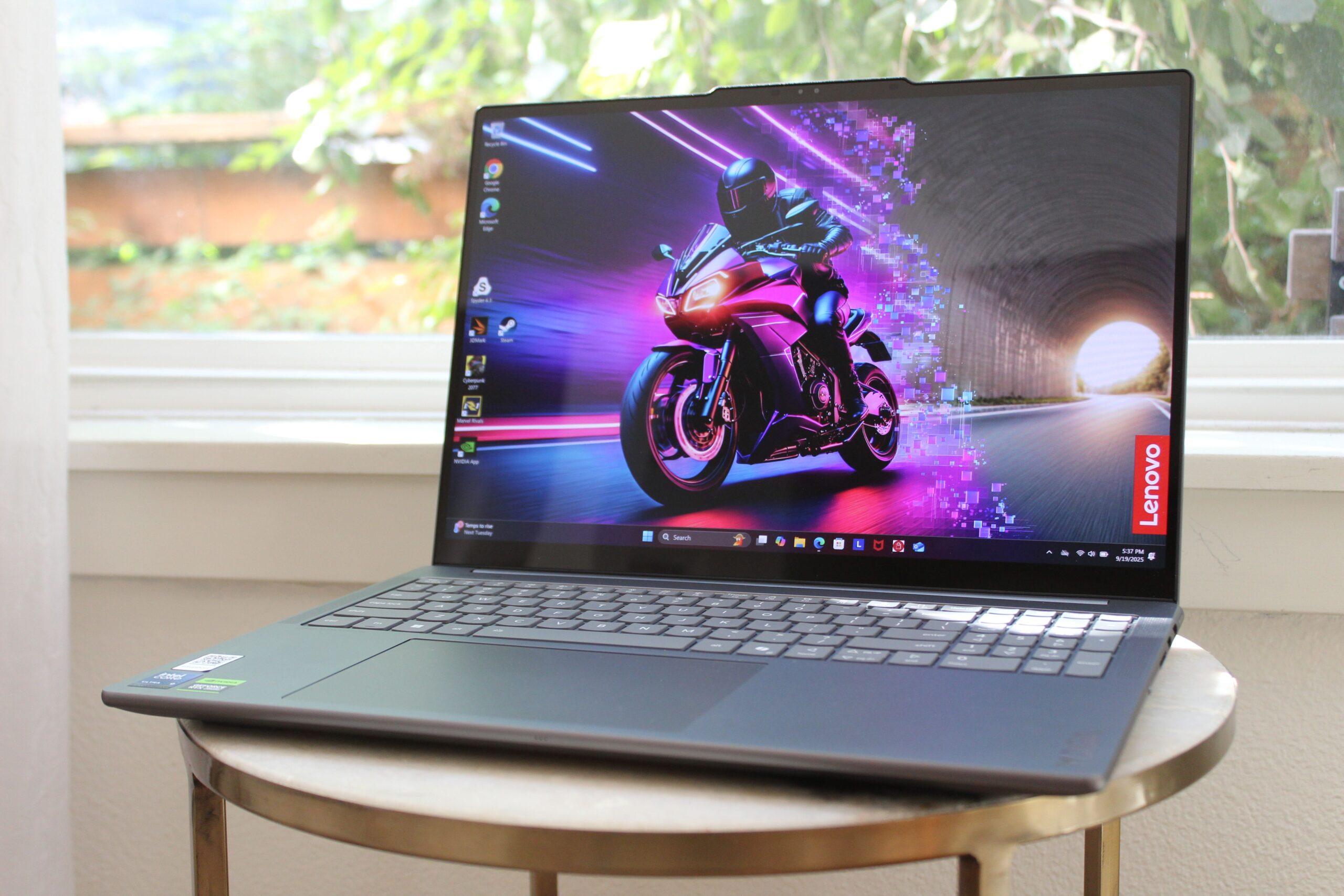The MacBook Air is a killer laptop, but at least it has some decent competition from the Windows side. The MacBook Pro, though? A high-powered content-creation laptop that also gets incredible battery life? There’s just nothing else out there like it.
That’s why I was excited to review the Lenovo Yoga Pro 9i 16, one of the few Windows laptops out there that at least attempts to rival the 16-inch MacBook Pro. With a powerful CPU and discrete RTX 5050 (or up to an RTX 5060), the Yoga Pro 9i 16 has the specs to compete as one of the best laptops, even if the lackluster battery life ultimately holds it back.
The Whole Package

Photograph: Luke Larsen
The Yoga Pro 9i 16 sports the same design as previous years, but it’s a handsome laptop. I like the soft, rounded edges, and the entire thing is built like a tank. The basic gray color Lenovo tends to use isn’t the most flattering shade, though. It’s a large laptop, made for high performance, and yet it’s surprisingly portable. It’s ever-so-slightly thicker and heavier than the 16-inch MacBook Pro and Samsung Galaxy Book4 Ultra but not enough to make a meaningful difference. These are very similar-size laptops, for all intents and purposes.
The keyboard and trackpad on the Yoga Pro 16i are both fantastic. They’re as good as they get on Windows laptops, allowing for quick, accurate typing and precise control. The oversize trackpad has perfect tracking and a quiet click, though I’d have preferred haptic feedback.

Photograph: Luke Larsen
Flanking either side of the keyboard are the upward-firing tweeters of this six-speaker audio setup. I’m happy to report that these are among the best speakers I’ve heard on a Windows laptop. They aren’t MacBook Pro-level, but they’re solid. In the reverse notch above the screen, you’ll also find the 1080p webcam, which is also decent. It has a zoomed-out framing, showing more of the background behind you. It’s clear, and it handles various lighting situations well, without overexposing my (admittedly pale) skin tone.
The port selection is great. It matches what the MacBook Pro has, except that it swaps out a Thunderbolt port for two USB-A ports. Not having USB-A on the MacBook Pro can be frustrating for the occasional accessory that still uses it. I do wish there were one more USB-C port on the right side for charging purposes. It’s especially frustrating since the proprietary Lenovo charging port (which looks a lot like USB-A at first glance) is on the same side as the two USB-C ports. Not being able to charge the device from both sides can be inconvenient. But I like the inclusion of the full-size SD card slot and HDMI.
Weirdly, Lenovo put the power button on the right side next to the ports. I’ve sometimes seen that on 2-in-1 laptops, but here it’s just asking to get accidentally bumped.
OLED, HDR, and Color Accuracy

Photograph: Luke Larsen
The Yoga Pro 9i 16 has a gorgeous OLED screen. The display resolution is 2,880 x 1,800 on my review unit, but there’s an upgrade option to a sharper 3,200 x 2,000. This would get the sharpness closer to the MacBook Pro’s 3,456 x 2,234 resolution. The higher-res Yoga Pro 9i also uses a tandem OLED screen, the same kind of technology seen in the iPad Pro. Lenovo claims this allows it to be cranked up to 1,000 nits of brightness.
Still, even my configuration had a density of 212 pixels per inch, which is plenty sharp. Lenovo is one of the few companies using OLED panels that can actually be cranked up to 500 nits in SDR. That’s important, as the majority of what you do on your laptop is not in HDR. And when you have a screen as glossy as this one, you need to be able to overpower it. I’m not going to lie, though, the reflections here are pretty extreme compared to the MacBook Pro, which does a better job of deflecting glare (even without the Nano Texture display). Some kind of anti-reflective coating might have been useful.
The other surprising miss with the display was color accuracy. I was getting an average color error of a Delta-E of 4.5, as measured with my SpyderPro colorimeter. For creator-focused displays, I like to see this number below two, even right out of the box. This is unusually bad for a laptop of this caliber. I recently tested Lenovo’s Legion 9i, which uses a similar OLED panel and has a spectacular color accuracy of Delta-E of 0.8. Lenovo said the color accuracy should be around 2.12. That makes me think it may have been a bug, though I was unable to resolve the issue after repeated tests. I would have hoped for a better color accuracy than 2.12, though calibration would likely be able to improve that.
The HDR implementation was a bit strange, too. In Windows, it says the display isn’t capable of supporting HDR games and apps. I can confirm that HDR works on the device, but I wasn’t able to properly test it. The inability to play games or run apps in HDR severely limits what this panel can do. OLED is still good in its own right, but missing HDR is a bummer. A Lenovo representative said that all HDR in apps and games should be supported, but I wasn’t able to fix that on my unit.
One thing this display does have over the MacBook Pro is a touch screen. While it’s not a true 2-in-1 laptop, the screen can also lie completely flat, which is another nice touch.
A Performer

Photograph: Luke Larsen
The RTX 5050 might not sound overly impressive since it’s the very bottom of Nvidia’s latest RTX 50-series lineup of GPUs. But unlike some RTX 5050 or 5060 laptops, the Yoga Pro 9i can deliver the full 100 watts of power to the RTX 5050, resulting in decent performance, especially when it’s set to Best Performance in Windows. Pair that with the capable Intel Core Ultra 9 285H, and you have a recipe for one of the better content creation laptops out there.
This is not exactly a gaming laptop, but you better believe I installed Marvel Rivals and Cyberpunk 2077 on this thing to at least try. Cyberpunk 2077 is a heavy game with lots of bells and whistles, but I was able to get some enjoyable frame rates without having to crank up upscaling or drop the settings much. With the resolution at 1600p, the game’s benchmark averaged 72 frames per second at the Ultra preset with DLSS set to Balanced. Ray tracing is not worth pursuing necessarily, but you can get even AAA games like Cyberpunk looking and playing great on this laptop. Fast-paced shooters like Marvel Rivals also play well, using more of that 120 Hz refresh rate and lower resolutions to hit higher frame rates.
This laptop’s performance in creative apps is far more important, as they use both the CPU and GPU in conjunction. Based on both the CPU and GPU performance I’m seeing here, I’m confident the Yoga Pro 9i is a solid video editing and content creation machine. You’ll get more mileage out of the M4 Max MacBook Pro, or a gaming laptop with a more powerful GPU like the RTX 5070 Ti or 5080, but those will also cost you significantly more. There’s enough GPU oomph to speed up workflows that just aren’t worth doing on standard laptops, which is exactly what the Yoga Pro 9i is designed for.

Photograph: Luke Larsen
We shouldn’t expect any Windows laptop with a powerful discrete GPU to truly replicate what the MacBook Pro does. Yes, there are more powerful systems out there, but efficiency is just not what those systems are about. Even with the improvements Nvidia has made in Advanced Optimus (automatic switching between discrete GPU when needed), the battery life suffers, especially while running heavier applications. On a local video playback test, the Yoga Pro 9i 16 lasted for around 12 hours. Despite using the same 84-watt-hour battery, this appears to be a slight improvement over last year’s model, though it’s hard to get an apples-to-apples comparison. I do know that its battery life diminishes quickly under heavy load, as it died in just 45 minutes while running a benchmark. You’ll want to be plugged in if you’re doing anything too serious.
Regardless of the task, you’ll get over twice the battery life on an M4 Max MacBook Pro. Not until we get ARM-based systems with powerful integrated graphics that rival the M4 Pro and M4 Max will there be competition for Apple. The closest thing we’ve seen so far is AMD’s unique Ryzen AI Max+ processor, which showed up on the Asus ROG Flow Z13 and used a massive integrated graphics chip to challenge traditional discrete graphics. But we’ve still got a long way to go.
The only other Windows laptop that could be better is the Asus ProArt P16, which I’ve yet to test. It now even comes with an RTX 5070 or 5090 option, which could make it significantly more powerful than the Yoga Pro 9i. However, it’s also a much more expensive laptop, configured with a 4K OLED screen and only higher-end GPUs. The Yoga Pro 9i is also hundreds of dollars cheaper than the Dell 16 Premium when similarly configured.
The Lenovo Yoga Pro 9i 16 gets a lot of things right—plenty enough to make it worth a recommendation as a valid MacBook Pro competitor. Ultimately, it’s the performance, display, and premium quality that make it a worthy content creation machine, and the Yoga Pro 9i succeeds on all those fronts, perhaps better than any other Windows machine I’ve tested.




